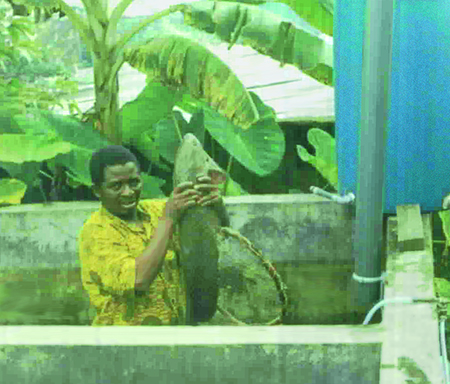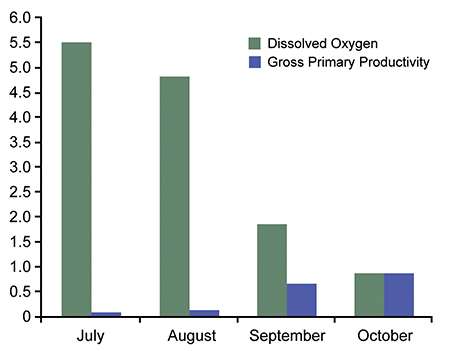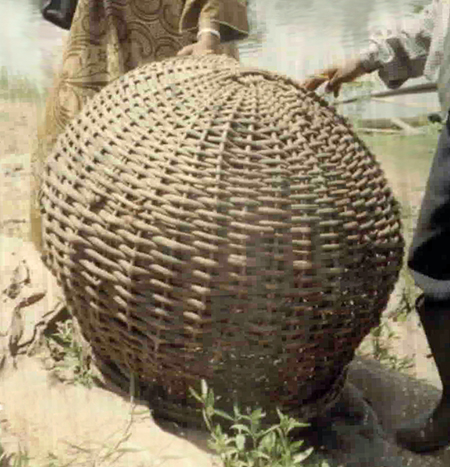Captive broodstock of indigenous fish other than catfish can thrive in concrete tanks

Fish farming on a commercial scale is almost nonexistent in Cameroon, but the current increased interest in this activity by the government and private institutions has promoted preliminary research work to obtain baseline data and establish viable broodstock.
The authors recently carried out the first successful domestication of African arrowana broodstock in concrete tanks in Buea, a mountainous region of Cameroon. The aim of the work has been the development of a broodstock that could be acclimated to captivity under experimental conditions with minimum input, given the resource-poor status of the target community where the technology might be later implemented.
African arrowana
Fish of the family Osteoglossidae (“bony tongues”) are primitive animals from the Jurassic era with fossil records that date back to the Eocene epoch. The African arrowana (Heterotis niloticus) is the only African representative of these fish, which are commonly considered the dinosaurs of the fish world.
The uncontrolled exploitation of wild arrowana stocks is the driving force behind research into the possibility of its culture in Cameroon. Because of its fast growth, large size, well-regarded taste and hardiness, arrowana are suitable candidates for commercial aquaculture.
Broodstock research

In the authors’ research, mature specimens of H. niloticus were collected during their breeding season in July 2002 around the swamps of the Mungo River in Cameroon using fish traps and drag nets. After collection, they were held and acclimatized in locally made holding baskets for three to six days.
Nineteen individuals were originally collected, but many died due to stress and injury associated with their method of capture. The five animals, four females and one male, that survived were kept in one tank from July to October 2002. The broodstock were transported using a mobile aeration system with compressed air.
A 5.5-cubic-meter outdoor concrete tank fitted with aeration and recirculation equipment was used to maintain the fish. A water pump moved clean or recycled water through a 1,000-liter overhead tank at 2.4 cubic meters per minute. The water was partly changed twice during the entire period. Using an air blower, aeration took place 15 minutes per hour. The tank was primarily rain-fed.
The tank was not fertilized and plankton was allowed to develop naturally. Supplementary feeding was done three times per day using locally available kitchen byproducts that consisted of a mixture of boiled tapioca flour, boiled cabbage, and dried shrimp. The fish received the diet at the rate of 1 percent of body weight in 5-mm-diameter pellets.
The quality of the tank water was monitored throughout the experiment, with the temperature maintained near the average monthly temperature of the swamps where the fish were collected.
Results

The H. niloticus remained very active throughout the experiment. Results indicated the arrowana could thrive in water of low productivity ranging 0.04 to 0.8mg per liter and with dissolved-oxygen levels of 0.8 to 5.5 milligram per liter. pH values varied 7.6 to 8.4, while temperatures ranged 20.4 to 23.0 degrees-C, and conductivity varied 41.5 to 84.9 μS per centimeter. Fig. 1 shows the monthly variations of gross primary productivity and dissolved oxygen in the tank. The productivity increased gradually as the dissolved oxygen decreased.
Although the temperatures in the tank were lower than those of the swamps, the fish seemed unaffected. The acclimatization in baskets, which were usually put under shady areas and therefore maintained lower temperatures, seemed to have contributed to this.
Gonadal examination of several sacrificed specimens showed over 1,000 eggs per female. The gonads were found to be in stages 4 to 7.
Conclusion
This study of African arrowana showed that captive broodstock of an indigenous fish species other than catfish can thrive in concrete tanks in Cameroon. This is of particular significance in the Mount Cameroon region where the experiment was carried out. Soils there are characterized by extreme rockiness and porosity, and are thus unsuitable for earthen ponds.
The results of this work can encourage the rearing of arrowana in local communities. The study represents a preliminary part of a wider project that aims to develop low-input, ecologically and economically sound technologies to manage viable captive broodstock of important food and ornamental species indigenous to Cameroon. Further research will study their reproduction in captivity under different culture techniques and rearing of juveniles to table size.
(Editor’s Note: This article was originally published in the October 2003 print edition of the Global Aquaculture Advocate.)
Now that you've finished reading the article ...
… we hope you’ll consider supporting our mission to document the evolution of the global aquaculture industry and share our vast network of contributors’ expansive knowledge every week.
By becoming a Global Seafood Alliance member, you’re ensuring that all of the pre-competitive work we do through member benefits, resources and events can continue. Individual membership costs just $50 a year. GSA individual and corporate members receive complimentary access to a series of GOAL virtual events beginning in April. Join now.
Not a GSA member? Join us.
Authors
-
Benedicta Oben, Ph.D.
Fisheries and Hydrobiology Unit
Faculty of Science
P.O. Box 63
University of Buea
S.W.P. Cameroon -
Pius Oben, Ph.D.
Department of Geology and Environmental Sciences
Faculty of Science
University of Buea
S.W.P. Cameroon
Tagged With
Related Posts

Intelligence
Aquaculture 2019: Triennial meeting examines global industry status
The triennial Aquaculture 2019 meeting – which also celebrated the 50thanniversary of the World Aquaculture Society – featured all segments of the aquaculture value chain during 104 technical sessions.

Health & Welfare
Atlantic cod genomics and broodstock development project
The Atlantic Cod Genomics and Broodstock Development Project has expanded the gene-related resources for the species in Canada.

Health & Welfare
Biosecurity principles for sustainable production using SPF shrimp
Basic components of biosecurity include knowledge of diseases, adequate detection methods and the use of “clean” shrimp stocks.

Health & Welfare
Examining domestication of green tiger shrimp in Egypt
The domestication of green tiger shrimp (Penaeus semisulcatus) as a source for seedstock could help expand aquaculture in Egypt. Trials by the authors compared the reproductive performance of wild male/wild female pairings with that of pond-reared male/pond-reared female and wild male/pond-reared female pairings.


